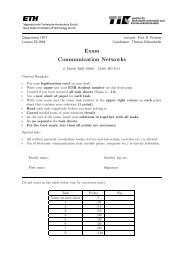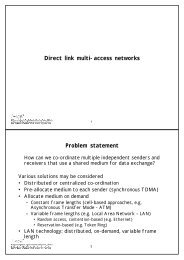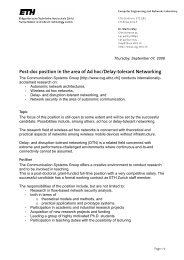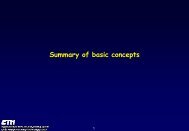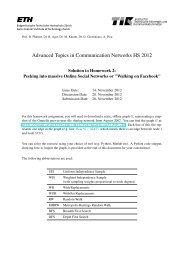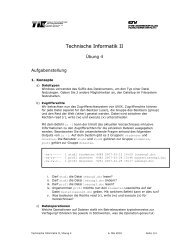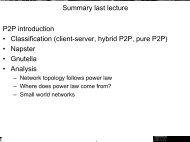Wireless LANs - Communication Systems Group
Wireless LANs - Communication Systems Group
Wireless LANs - Communication Systems Group
Create successful ePaper yourself
Turn your PDF publications into a flip-book with our unique Google optimized e-Paper software.
<strong>Wireless</strong> <strong>LANs</strong><br />
q Characteristics<br />
q IEEE 802.11<br />
q PHY<br />
q MAC<br />
q Roaming<br />
q .11a, b, g, h, i …<br />
Textbooks: Jochen Schiller, Mobile <strong>Communication</strong>s / Mobilkommunikation, published<br />
by Pearson, available in English and German<br />
http://www.inf.fu-berlin.de/inst/ag-tech/resources/mobile_communications.htm<br />
Slides courtesy of Prof. Dr.-Ing. Jochen Schiller, http://www.jochenschiller.de/ 1<br />
Characteristics of wireless <strong>LANs</strong><br />
Advantages<br />
q very flexible within the reception area<br />
q Ad-hoc networks without previous planning possible<br />
q (almost) no wiring difficulties (e.g. historic buildings, firewalls)<br />
q more robust against disasters like, e.g., earthquakes, fire - or users pulling<br />
a plug...<br />
Disadvantages<br />
q typically very low bandwidth compared to wired networks<br />
(1-10 Mbit/s)<br />
q many proprietary solutions, especially for higher bit-rates, standards take<br />
their time (e.g. IEEE 802.11)<br />
q products have to follow many national restrictions if working wireless, it<br />
takes a very long time to establish global solutions like, e.g., IMT-2000<br />
Slides courtesy of Prof. Dr.-Ing. Jochen Schiller, http://www.jochenschiller.de/ 2
Design goals for wireless <strong>LANs</strong><br />
q global, seamless operation<br />
q low power for battery use<br />
q no special permissions or licenses needed to use the LAN<br />
q robust transmission technology<br />
q simplified spontaneous cooperation at meetings<br />
q easy to use for everyone, simple management<br />
q protection of investment in wired networks<br />
q security (no one should be able to read my data), privacy (no one should<br />
be able to collect user profiles), safety (low radiation)<br />
q transparency concerning applications and higher layer protocols, but also<br />
location awareness if necessary<br />
Slides courtesy of Prof. Dr.-Ing. Jochen Schiller, http://www.jochenschiller.de/ 3<br />
Comparison: infrared vs. radio transmission<br />
Infrared<br />
q<br />
Advantages<br />
q<br />
q<br />
q<br />
uses IR diodes, diffuse light,<br />
multiple reflections (walls,<br />
furniture etc.)<br />
simple, cheap, available in<br />
many mobile devices<br />
no licenses needed<br />
simple shielding possible<br />
Disadvantages<br />
q<br />
q<br />
q<br />
Example<br />
q<br />
interference by sunlight, heat<br />
sources etc.<br />
many things shield or absorb IR<br />
light<br />
low bandwidth<br />
IrDA (Infrared Data Association)<br />
interface available everywhere<br />
Radio<br />
q<br />
Advantages<br />
q<br />
q<br />
typically using the license free<br />
ISM band at 2.4 GHz<br />
experience from wireless WAN<br />
and mobile phones can be used<br />
coverage of larger areas<br />
possible (radio can penetrate<br />
walls, furniture etc.)<br />
Disadvantages<br />
q<br />
q<br />
Example<br />
q<br />
very limited license free<br />
frequency bands<br />
shielding more difficult,<br />
interference with other electrical<br />
devices<br />
WaveLAN, HIPERLAN,<br />
Bluetooth<br />
Slides courtesy of Prof. Dr.-Ing. Jochen Schiller, http://www.jochenschiller.de/ 4
Comparison: infrastructure vs. ad-hoc networks<br />
infrastructure<br />
network<br />
AP<br />
AP<br />
wired network<br />
AP: Access Point<br />
AP<br />
ad-hoc network<br />
Slides courtesy of Prof. Dr.-Ing. Jochen Schiller, http://www.jochenschiller.de/ 5<br />
802.11 - Architecture of an infrastructure network<br />
ESS<br />
802.11 LAN<br />
BSS 1<br />
Access<br />
Point<br />
BSS 2<br />
Distribution System<br />
Access<br />
Point<br />
802.11 LAN<br />
802.x LAN<br />
Portal<br />
Station (STA)<br />
q<br />
terminal with access mechanisms<br />
to the wireless medium and radio<br />
contact to the access point<br />
Basic Service Set (BSS)<br />
q<br />
group of stations using the same<br />
radio frequency<br />
Access Point<br />
q<br />
Portal<br />
q<br />
station integrated into the wireless<br />
LAN and the distribution system<br />
bridge to other (wired) networks<br />
Distribution System<br />
q<br />
interconnection network to form<br />
one logical network (EES:<br />
Extended Service Set) based<br />
on several BSS<br />
STA 1<br />
STA 2 STA 3<br />
Slides courtesy of Prof. Dr.-Ing. Jochen Schiller, http://www.jochenschiller.de/ 6
802.11 - Architecture of an ad-hoc network<br />
802.11 LAN<br />
IBSS 1<br />
STA 2<br />
STA 3<br />
Direct communication within a limited<br />
range<br />
q<br />
q<br />
Station (STA):<br />
terminal with access mechanisms to<br />
the wireless medium<br />
Independent Basic Service Set<br />
(IBSS):<br />
group of stations using the same<br />
radio frequency<br />
STA 1<br />
STA 4<br />
STA 5<br />
IBSS 2<br />
802.11 LAN<br />
Slides courtesy of Prof. Dr.-Ing. Jochen Schiller, http://www.jochenschiller.de/ 7<br />
IEEE standard 802.11<br />
mobile terminal<br />
fixed<br />
terminal<br />
infrastructure<br />
network<br />
application<br />
TCP<br />
IP<br />
LLC<br />
access point<br />
LLC<br />
application<br />
TCP<br />
IP<br />
LLC<br />
802.11 MAC<br />
802.11 MAC<br />
802.3 MAC<br />
802.3 MAC<br />
802.11 PHY<br />
802.11 PHY<br />
802.3 PHY<br />
802.3 PHY<br />
Slides courtesy of Prof. Dr.-Ing. Jochen Schiller, http://www.jochenschiller.de/ 8
802.11 - Layers and functions<br />
MAC<br />
q<br />
access mechanisms, fragmentation,<br />
encryption<br />
MAC Management<br />
q<br />
synchronization, roaming, MIB,<br />
power management<br />
PLCP Physical Layer Convergence Protocol<br />
q<br />
clear channel assessment signal<br />
(carrier sense)<br />
PMD Physical Medium Dependent<br />
q<br />
modulation, coding<br />
PHY Management<br />
q<br />
channel selection, MIB<br />
Station Management<br />
q<br />
coordination of all management<br />
functions<br />
PHY DLC<br />
LLC<br />
MAC<br />
PLCP<br />
PMD<br />
MAC Management<br />
PHY Management<br />
Station Management<br />
Slides courtesy of Prof. Dr.-Ing. Jochen Schiller, http://www.jochenschiller.de/ 9<br />
802.11 - Physical layer<br />
3 versions: 2 radio (typ. 2.4 GHz), 1 IR<br />
q data rates 1 or 2 Mbit/s<br />
FHSS (Frequency Hopping Spread Spectrum)<br />
q spreading, despreading, signal strength, typ. 1 Mbit/s<br />
q min. 2.5 frequency hops/s (USA), two-level Gaussian FSK modulation<br />
DSSS (Direct Sequence Spread Spectrum)<br />
Infrared<br />
q DBPSK modulation for 1 Mbit/s (Differential Binary Phase Shift Keying),<br />
DQPSK for 2 Mbit/s (Differential Quadrature PSK)<br />
q preamble and header of a frame is always transmitted with 1 Mbit/s, rest<br />
of transmission 1 or 2 Mbit/s<br />
q chipping sequence: +1, -1, +1, +1, -1, +1, +1, +1, -1, -1, -1 (Barker code)<br />
q max. radiated power 1 W (USA), 100 mW (EU), min. 1mW<br />
q 850-950 nm, diffuse light, typ. 10 m range<br />
q carrier detection, energy detection, synchonization<br />
Slides courtesy of Prof. Dr.-Ing. Jochen Schiller, http://www.jochenschiller.de/ 10
A short digression: Basics of spread spectrum<br />
communication<br />
Slides courtesy of Prof. Dr.-Ing. Jochen Schiller, http://www.jochenschiller.de/ 11<br />
Effects of spreading and interference<br />
dP/df<br />
dP/df<br />
i)<br />
f<br />
ii)<br />
f<br />
user signal<br />
broadband interference<br />
narrowband interference<br />
sender<br />
dP/df<br />
dP/df<br />
dP/df<br />
iii)<br />
iv)<br />
v)<br />
f<br />
receiver<br />
f<br />
f<br />
Slides courtesy of Prof. Dr.-Ing. Jochen Schiller, http://www.jochenschiller.de/ 12
Spreading and frequency selective fading<br />
channel<br />
quality<br />
1<br />
narrow band<br />
signal<br />
2<br />
3<br />
4<br />
guard space<br />
5 6<br />
frequency<br />
narrowband channels<br />
channel<br />
quality<br />
2<br />
2<br />
2<br />
2<br />
2<br />
1<br />
spread spectrum channels<br />
spread<br />
spectrum<br />
frequency<br />
Slides courtesy of Prof. Dr.-Ing. Jochen Schiller, http://www.jochenschiller.de/ 13<br />
DSSS (Direct Sequence Spread Spectrum) I<br />
XOR of the signal with pseudo-random number (chipping sequence)<br />
q many chips per bit (e.g., 128) result in higher bandwidth of the signal<br />
Advantages<br />
q reduces frequency selective<br />
fading<br />
q in cellular networks<br />
• base stations can use the<br />
same frequency range<br />
• several base stations can<br />
detect and recover the signal<br />
• soft handover<br />
Disadvantages<br />
q precise power control necessary<br />
t b<br />
t c<br />
0 1<br />
0 1 1 0 1 0 1 0 1 1 0 1 0 1<br />
0 1 1 0 1 0 1 1 0 0 1 0 1 0<br />
t b : bit period<br />
t c : chip period<br />
user data<br />
XOR<br />
chipping<br />
sequence<br />
=<br />
resulting<br />
signal<br />
Slides courtesy of Prof. Dr.-Ing. Jochen Schiller, http://www.jochenschiller.de/ 14
DSSS (Direct Sequence Spread Spectrum) II<br />
user data<br />
X<br />
spread<br />
spectrum<br />
signal<br />
modulator<br />
transmit<br />
signal<br />
chipping<br />
sequence<br />
radio<br />
carrier<br />
transmitter<br />
correlator<br />
received<br />
signal<br />
demodulator<br />
lowpass<br />
filtered<br />
signal<br />
X<br />
products<br />
integrator<br />
sampled<br />
sums<br />
decision<br />
data<br />
radio<br />
carrier<br />
chipping<br />
sequence<br />
receiver<br />
Slides courtesy of Prof. Dr.-Ing. Jochen Schiller, http://www.jochenschiller.de/ 15<br />
FHSS (Frequency Hopping Spread Spectrum) I<br />
Discrete changes of carrier frequency<br />
q sequence of frequency changes determined via pseudo random number<br />
sequence<br />
Two versions<br />
q Fast Hopping:<br />
several frequencies per user bit<br />
q Slow Hopping:<br />
several user bits per frequency<br />
Advantages<br />
q frequency selective fading and interference limited to short period<br />
q simple implementation<br />
q uses only small portion of spectrum at any time<br />
Disadvantages<br />
q not as robust as DSSS<br />
q simpler to detect<br />
Slides courtesy of Prof. Dr.-Ing. Jochen Schiller, http://www.jochenschiller.de/ 16
FHSS (Frequency Hopping Spread Spectrum) II<br />
0 1<br />
t b<br />
0 1 1 t<br />
user data<br />
f<br />
f 3<br />
f 2<br />
f 1<br />
t d<br />
slow<br />
hopping<br />
(3 bits/hop)<br />
f<br />
t<br />
t d<br />
t b : bit period t d : dwell time<br />
f 3<br />
f 2<br />
f 1<br />
fast<br />
hopping<br />
(3 hops/bit)<br />
t<br />
Slides courtesy of Prof. Dr.-Ing. Jochen Schiller, http://www.jochenschiller.de/ 17<br />
FHSS (Frequency Hopping Spread Spectrum) III<br />
user data<br />
modulator<br />
narrowband<br />
signal<br />
modulator<br />
spread<br />
transmit<br />
signal<br />
transmitter<br />
frequency<br />
synthesizer<br />
hopping<br />
sequence<br />
received<br />
signal<br />
demodulator<br />
narrowband<br />
signal<br />
demodulator<br />
data<br />
hopping<br />
sequence<br />
frequency<br />
synthesizer<br />
receiver<br />
Slides courtesy of Prof. Dr.-Ing. Jochen Schiller, http://www.jochenschiller.de/ 18
End of digression<br />
Slides courtesy of Prof. Dr.-Ing. Jochen Schiller, http://www.jochenschiller.de/ 19<br />
DSSS PHY packet format<br />
Synchronization<br />
q synch., gain setting, energy detection, frequency offset compensation<br />
SFD (Start Frame Delimiter)<br />
q 1111001110100000<br />
Signal<br />
q data rate of the payload (0A: 1 Mbit/s DBPSK; 14: 2 Mbit/s DQPSK)<br />
Service<br />
Length<br />
q future use, 00: 802.11 compliant<br />
q length of the payload<br />
HEC (Header Error Check)<br />
q protection of signal, service and length, x 16 +x 12 +x 5 +1<br />
128 16 8 8 16 16 variable bits<br />
synchronization SFD signal service length HEC payload<br />
PLCP preamble<br />
PLCP header<br />
Slides courtesy of Prof. Dr.-Ing. Jochen Schiller, http://www.jochenschiller.de/ 20
802.11 - MAC layer I - DFWMAC<br />
Traffic services<br />
q Asynchronous Data Service (mandatory)<br />
• exchange of data packets based on “best-effort”<br />
• support of broadcast and multicast<br />
q Time-Bounded Service (optional)<br />
• implemented using PCF (Point Coordination Function)<br />
Access methods<br />
q DFWMAC-DCF CSMA/CA (mandatory)<br />
• collision avoidance via randomized „back-off“ mechanism<br />
• minimum distance between consecutive packets<br />
• ACK packet for acknowledgements (not for broadcasts)<br />
q DFWMAC-DCF w/ RTS/CTS (optional)<br />
• Distributed Foundation <strong>Wireless</strong> MAC<br />
• avoids hidden terminal problem<br />
q DFWMAC- PCF (optional)<br />
• access point polls terminals according to a list<br />
Distributed<br />
Foundation<br />
<strong>Wireless</strong> Medium<br />
Access Control<br />
Distributed<br />
Coordination<br />
Function<br />
Slides courtesy of Prof. Dr.-Ing. Jochen Schiller, http://www.jochenschiller.de/ 21<br />
802.11 - MAC layer II<br />
Priorities<br />
q defined through different inter frame spaces<br />
q no guaranteed, hard priorities<br />
q SIFS (Short Inter Frame Spacing)<br />
• highest priority, for ACK, CTS, polling response<br />
q PIFS (PCF Inter Frame Spacing)<br />
• medium priority, for time-bounded service using PCF<br />
q DIFS (DCF, Distributed Coordination Function Inter Frame Spacing)<br />
• lowest priority, for asynchronous data service<br />
DIFS<br />
DIFS<br />
medium busy<br />
PIFS<br />
SIFS<br />
contention<br />
next frame<br />
direct access if<br />
medium is free ≥ DIFS<br />
t<br />
Slides courtesy of Prof. Dr.-Ing. Jochen Schiller, http://www.jochenschiller.de/ 22
802.11 - CSMA/CA access method I<br />
DIFS<br />
DIFS<br />
contention window<br />
(randomized back-off<br />
mechanism)<br />
medium busy<br />
direct access if<br />
medium is free ≥ DIFS<br />
slot time<br />
next frame<br />
t<br />
q station ready to send starts sensing the medium (Carrier Sense<br />
based on CCA, Clear Channel Assessment)<br />
q if the medium is free for the duration of an Inter-Frame Space (IFS),<br />
the station can start sending (IFS depends on service type)<br />
q if the medium is busy, the station has to wait for a free IFS, then the<br />
station must additionally wait a random back-off time (collision<br />
avoidance, multiple of slot-time)<br />
q if another station occupies the medium during the back-off time of<br />
the station, the back-off timer stops (fairness)<br />
Slides courtesy of Prof. Dr.-Ing. Jochen Schiller, http://www.jochenschiller.de/ 23<br />
802.11 - competing stations<br />
DIFS<br />
DIFS<br />
bo e<br />
bo r<br />
DIFS<br />
bo e bo r<br />
DIFS<br />
bo e<br />
busy<br />
station 1<br />
bo e<br />
busy<br />
station 2<br />
busy<br />
station 3<br />
bo e<br />
busy<br />
bo e<br />
bo r<br />
station 4<br />
bo e<br />
bo r<br />
bo e<br />
busy<br />
bo e<br />
bo r<br />
station 5<br />
t<br />
busy<br />
medium not idle (frame, ack etc.)<br />
bo e<br />
elapsed backoff time<br />
packet arrival at MAC<br />
bo r<br />
residual backoff time<br />
Slides courtesy of Prof. Dr.-Ing. Jochen Schiller, http://www.jochenschiller.de/ 24
802.11 - CSMA/CA access method II<br />
Sending unicast packets<br />
q station has to wait for DIFS before sending data<br />
q receivers acknowledge at once (after waiting for SIFS) if the packet was<br />
received correctly (CRC)<br />
q automatic retransmission of data packets in case of transmission errors<br />
sender<br />
DIFS<br />
data<br />
receiver<br />
SIFS<br />
ACK<br />
other<br />
stations<br />
waiting time<br />
DIFS<br />
contention<br />
data<br />
t<br />
Slides courtesy of Prof. Dr.-Ing. Jochen Schiller, http://www.jochenschiller.de/ 25<br />
802.11 – DFWMAC (CSMA/CA: Collision Avoidance, also called<br />
Multiple Access CA - MACA)<br />
Sending unicast packets<br />
q station can send RTS with reservation parameter after waiting for DIFS<br />
(reservation determines amount of time the data packet needs the medium)<br />
q acknowledgement via CTS after SIFS by receiver (if ready to receive)<br />
q sender can now send data at once, acknowledgement via ACK<br />
q other stations store medium reservations distributed via RTS and CTS<br />
(Station store the Net Allocation Vector (NAV))<br />
sender<br />
DIFS<br />
RTS<br />
data<br />
receiver<br />
SIFS<br />
CTS<br />
SIFS<br />
SIFS<br />
ACK<br />
other<br />
stations<br />
NAV (RTS)<br />
NAV (CTS)<br />
defer access<br />
DIFS<br />
contention<br />
data<br />
t<br />
Slides courtesy of Prof. Dr.-Ing. Jochen Schiller, http://www.jochenschiller.de/ 26
Fragmentation<br />
q<br />
q<br />
q<br />
Sender may fragment large data frames<br />
Purpose: decrease the probability of frame errors in difficult<br />
environments<br />
Fragment sizes may be adapted to fit error behavior of medium<br />
sender<br />
DIFS<br />
RTS<br />
frag 1<br />
frag 2<br />
receiver<br />
SIFS<br />
CTS<br />
SIFS<br />
SIFS<br />
ACK<br />
SIFS<br />
1<br />
SIFS<br />
ACK2<br />
other<br />
stations<br />
NAV (RTS)<br />
NAV (CTS)<br />
NAV (frag 1 )<br />
NAV (ACK 1 )<br />
DIFS<br />
contention<br />
data<br />
t<br />
Slides courtesy of Prof. Dr.-Ing. Jochen Schiller, http://www.jochenschiller.de/ 27<br />
DFWMAC-PCF I<br />
q<br />
q<br />
q<br />
q<br />
Base station may establish framing contention-free polling<br />
Used for QoS-sensitive applications<br />
Superframe consists of contention-free period and period with<br />
contention<br />
Not possible in ad-hoc mode<br />
t 0<br />
t 1<br />
SuperFrame<br />
medium busy<br />
PIFS<br />
SIFS<br />
SIFS<br />
point<br />
coordinator<br />
D 1<br />
SIFS<br />
U 1<br />
D 2<br />
SIFS<br />
U 2<br />
wireless<br />
stations<br />
stations‘<br />
NAV<br />
NAV<br />
Slides courtesy of Prof. Dr.-Ing. Jochen Schiller, http://www.jochenschiller.de/ 28
DFWMAC-PCF II<br />
t 2 t 3 t 4<br />
point<br />
coordinator<br />
D 3<br />
PIFS<br />
D 4<br />
SIFS<br />
U 4<br />
SIFS<br />
CFend<br />
wireless<br />
stations<br />
stations‘<br />
NAV<br />
NAV<br />
contention free period<br />
contention<br />
period<br />
t<br />
Slides courtesy of Prof. Dr.-Ing. Jochen Schiller, http://www.jochenschiller.de/ 29<br />
802.11 - Frame format<br />
Types<br />
q control frames, management frames, data frames<br />
Sequence numbers<br />
q important against duplicated frames due to lost ACKs<br />
Addresses<br />
q receiver, transmitter (physical), BSS identifier, sender (logical)<br />
Miscellaneous<br />
bytes<br />
q sending time, checksum, frame control, data<br />
2 2 6 6 6 6<br />
Duration/<br />
ID<br />
Address<br />
1<br />
Address<br />
2<br />
Address<br />
3<br />
Sequence<br />
Control<br />
Frame<br />
Control<br />
Protocol<br />
version<br />
Type Subtype<br />
To<br />
DS<br />
More<br />
Frag<br />
Power<br />
Retry<br />
Mgmt<br />
2 0-2312 4<br />
Address<br />
Data<br />
4<br />
bits 2 2 4 1 1 1 1 1 1 1 1<br />
From<br />
DS<br />
More<br />
Data<br />
WEP<br />
Order<br />
CRC<br />
Slides courtesy of Prof. Dr.-Ing. Jochen Schiller, http://www.jochenschiller.de/ 30
MAC address format<br />
scenario<br />
to DS from address 1<br />
DS (phys. dest.)<br />
ad-hoc network 0 0 DA<br />
(phys. dest.)<br />
infrastructure<br />
network, from AP<br />
infrastructure<br />
network, to AP<br />
infrastructure<br />
network, within DS<br />
0 1 DA<br />
(log & phys.<br />
dest.)<br />
1 0 BSSID<br />
(phys. dest.)<br />
1 1 RA<br />
(phys. dest.)<br />
address 2<br />
(phys. source)<br />
SA<br />
(phys. source)<br />
BSSID<br />
(phys. source.)<br />
SA<br />
(log & phys.<br />
source)<br />
TA<br />
(phys. source)<br />
address 3<br />
(log. Addr.)<br />
address 4<br />
(log. Addr.)<br />
BSSID -<br />
SA<br />
(log. source)<br />
DA<br />
(log. dest)<br />
DA<br />
(log. dest)<br />
-<br />
-<br />
SA<br />
(log. source)<br />
DS: Distribution System<br />
AP: Access Point<br />
DA: Destination Address<br />
SA: Source Address<br />
BSSID: Basic Service Set Identifier<br />
RA: Receiver Address<br />
TA: Transmitter Address<br />
Slides courtesy of Prof. Dr.-Ing. Jochen Schiller, http://www.jochenschiller.de/ 31<br />
802.11 - MAC management<br />
Synchronization<br />
q try to find a LAN, try to stay within a LAN<br />
q clocks, timers etc.<br />
Power management<br />
q sleep-mode without missing a message<br />
q periodic sleep, frame buffering, traffic measurements<br />
Association/Reassociation<br />
q integration into a LAN<br />
q roaming, i.e. change networks by changing access points<br />
q scanning, i.e. active search for a network<br />
MIB - Management Information Base<br />
q managing, read, write<br />
Slides courtesy of Prof. Dr.-Ing. Jochen Schiller, http://www.jochenschiller.de/ 32
Synchronization using a Beacon (infrastructure)<br />
q<br />
q<br />
q<br />
q<br />
Are sent at regular intervals (schedule)<br />
Beacon frames are sent using DIFS + random backoff interval<br />
Beacon frames contain timestamp, BSSID, other management information<br />
If delayed, contain actual time in timestamp<br />
beacon interval<br />
access<br />
point<br />
medium<br />
B<br />
B B B<br />
busy busy busy busy<br />
value of the timestamp B beacon frame<br />
t<br />
Slides courtesy of Prof. Dr.-Ing. Jochen Schiller, http://www.jochenschiller.de/ 33<br />
Synchronization using a Beacon (ad-hoc)<br />
q<br />
Winner of contention will serve as a beaconing station<br />
beacon interval<br />
station 1<br />
B 1<br />
B 1<br />
station 2<br />
B 2 B 2<br />
random delay<br />
medium<br />
busy<br />
busy busy busy<br />
value of the timestamp B beacon frame<br />
t<br />
Slides courtesy of Prof. Dr.-Ing. Jochen Schiller, http://www.jochenschiller.de/ 34
802.11 - Roaming<br />
No connection or bad connection Then perform:<br />
Scanning<br />
q scan the environment, i.e., listen into the medium for beacon signals or<br />
send probes into the medium and wait for an answer<br />
Reassociation Request<br />
q station sends a request to one or several AP(s)<br />
Reassociation Response<br />
q success: AP has answered, station can now participate<br />
q failure: continue scanning<br />
AP accepts Reassociation Request<br />
q signal the new station to the distribution system<br />
q the distribution system updates its data base (i.e., location information)<br />
q typically, the distribution system now informs the old AP so it can release<br />
resources<br />
Slides courtesy of Prof. Dr.-Ing. Jochen Schiller, http://www.jochenschiller.de/ 35<br />
WLAN: IEEE 802.11b<br />
Data rate<br />
q<br />
1, 2, 5.5, 11 Mbit/s, depending on<br />
SNR<br />
q User data rate max. approx. 6<br />
Mbit/s<br />
Transmission range<br />
q<br />
q<br />
Frequency<br />
q<br />
Security<br />
Cost<br />
q<br />
q<br />
Availability<br />
q<br />
300m outdoor, 30m indoor<br />
Max. data rate ~10m indoor<br />
Free 2.4 GHz ISM-band<br />
Limited, WEP insecure, SSID<br />
100€ adapter, 250€ base station,<br />
dropping<br />
Many products, many vendors<br />
Connection set-up time<br />
q Connectionless/always on<br />
Quality of Service<br />
q Typ. Best effort, no guarantees<br />
(unless polling is used, limited<br />
support in products)<br />
Manageability<br />
q Limited (no automated key<br />
distribution, sym. Encryption)<br />
Special Advantages/Disadvantages<br />
q Advantage: many installed systems,<br />
lot of experience, available<br />
worldwide, free ISM-band, many<br />
vendors, integrated in laptops,<br />
simple system<br />
q Disadvantage: heavy interference<br />
on ISM-band, no service<br />
guarantees, slow relative speed<br />
only<br />
Slides courtesy of Prof. Dr.-Ing. Jochen Schiller, http://www.jochenschiller.de/ 36
IEEE 802.11b – PHY frame formats<br />
Long PLCP PPDU format<br />
128 16 8 8 16 16 variable bits<br />
synchronization SFD signal service length HEC payload<br />
PLCP preamble<br />
PLCP header<br />
192 µs at 1 Mbit/s DBPSK 1, 2, 5.5 or 11 Mbit/s<br />
Short PLCP PPDU format (optional)<br />
56 16 8 8 16 16 variable bits<br />
short synch. SFD signal service length HEC payload<br />
PLCP preamble<br />
(1 Mbit/s, DBPSK)<br />
PLCP header<br />
(2 Mbit/s, DQPSK)<br />
96 µs 2, 5.5 or 11 Mbit/s<br />
Slides courtesy of Prof. Dr.-Ing. Jochen Schiller, http://www.jochenschiller.de/ 37<br />
Channel selection (non-overlapping)<br />
Europe (ETSI)<br />
channel 1 channel 7 channel 13<br />
2400 2412 2442 2472 2483.5<br />
22 MHz<br />
[MHz]<br />
US (FCC)/Canada (IC)<br />
channel 1 channel 6 channel 11<br />
2400<br />
2412 2437 2462 2483.5<br />
22 MHz<br />
[MHz]<br />
Slides courtesy of Prof. Dr.-Ing. Jochen Schiller, http://www.jochenschiller.de/ 38
IEEE 802.11 overview<br />
q<br />
q<br />
q<br />
q<br />
q<br />
q<br />
Standard for <strong>Wireless</strong> Local Area Networks, developed by the IEEE,<br />
see http://grouper.ieee.org/groups/802/11/<br />
802.11b: max. 11 Mbit/s, using 8-Chip Complementary Code Keying<br />
(CCK) at 2.4 GHz; commercial breakthrough; downgrade to 1, 2, 5.5<br />
Mbit/s. Channel bands of 22 MHz.<br />
802.11a: max. 54 Mbit/s, using Orthogonal FDM (OFDM) at 5 GHz.<br />
Channel bands of 100 MHz, smaller cells than 802.11b. Unlicenced<br />
use allowed only indoors.<br />
802.11g: max. 54 Mbit/s, improved OFDM modulation at 2.4 GHz. Can<br />
co-exist with 802.11b; multi-mode implementations available.<br />
802.11h: European version of 802.11a, implements dynamic<br />
transmission power management to fit European regulations.<br />
802.11e: QoS extensions with DCF<br />
q 802.11f: Inter-Access-Point Protocol; improves roaming<br />
q 802.11i: Improved security, interworking with 802.1x<br />
Slides courtesy of Prof. Dr.-Ing. Jochen Schiller, http://www.jochenschiller.de/ 39



